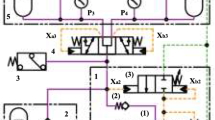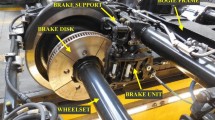Abstract
Tests with a prescribed deceleration pulse are fundamental to the development and certification of crashworthy structures. At the Politecnico di Milano Laboratory for the Safety of Transports these tests are carried out using a horizontal impact-sled facility. Test articles are mounted on a trolley which is launched down a rail and then arrested by means of a braking system that allows prescribed deceleration pulses to be obtained. The oleo-pneumatic braking system customarily used in these tests is difficult to use and user-defined time-histories of the deceleration pulse cannot be obtained. In an effort to overcome these limits, a new braking system was developed. The idea was to arrest the trolley by means of a number of beams that varied in length and that were positioned at variable distances from each other. Experimental tests and numerical simulations were carried out in parallel to verify the feasibility of the new system and improve on the initial design. A mathematical model and genetic algorithm were also developed and used as part of a method to find the test set-up that allowed user-defined deceleration pulses to be obtained. A full-scale test with the deceleration pulse prescribed for small airplane seat certification was carried out to assess the performance of the braking system. The test revealed a weakness of the braking system that was then further developed before being put into full operational service.



















Similar content being viewed by others
Notes
At LAST the development of an assisted servo braking system was started but then abandoned because of weight considerations.
For the sake of completeness, it should be mentioned that Fe430 is one of the commercial names of a mild stainless steel used for pipes and profiles characterized by a nominal ultimate tensile strength of 430 MPa. Equivalent designations for the Fe430 steel are: UNI 7070, Fe 430 B (Italy); EN 10025-90+A1-9, S275JR (Europe); BS 4360, 43 B (UK); ASTM, A 36/A 283 D (USA).
In order to reduce the computational time, the velocity of the hook in the simulations was higher than that in the tests.
Federal Aviation Regulation, Part 23 “Airworthiness standards: Normal, Utility, Acrobatic, and Commuter Category Airplanes”, Section 562 “Emergency landing dynamic conditions”.
Joint Aviation Requirements, Part 23 “Normal, Utility, Aerobatic and Commuter Category Aeroplanes”, Section 562 “Emergency landing dynamic conditions”
The maximum number of steps was set equal to the estimated number of allowable set-ups of the braking system.
Abbreviations
- FAA:
-
Federal Aviation Administration
- FAR:
-
Federal Aviation Requirements
- JAA:
-
Joint Aviation Authorities
- JAR:
-
Joint Aviation Regulations
- EASA:
-
European Aviation Safety Agency
- FIA:
-
Fédération Internationale de l’Automobile
- LaST:
-
Laboratorio per la Sicurezza dei Trasporti
- HISF:
-
Horizontal Impact Sled Facility
- LSTC:
-
Livermore Software Technology Corporation
- FEM:
-
Finite Element Method
- LVDT:
-
Linear Variable Differential Transformer
- GA:
-
Genetic Algorithms
- APE:
-
Average Percentage Error
- RMAE:
-
Relative Maximum Absolute Error
- LRV:
-
Light Railway Vehicle
References
Federal Aviation Administration (2006) Code of Federal Regulations, Part 27– Airworthiness Standards: Normal Category Rotorcraft and Part 29– Airworthiness Standards: Transport Category Rotorcraft. April 26, 2006
Joint Aviation Authorities (2004) Joint Aviation Requirements, JAR-27: Small Rotorcraft and JAR-29: Large Rotorcraft. November 1, 2004
Federation Internationale de L’automobile (2003) Norme 8855-1999 / Standard 8855-1999, Norme FIA Pour Sieges De Competition / FIA Standard For Competition Seats. February 14, 2003
Juhasz PR, Parson RP (1980) Computer velocity control of a sled used in impact studies. In: Instrumentation in the Aerospace Industry, Vol. 26, Advanced in test measurement, Vol. 17, Part One, Proceedings of the 26th Inter-Nation Instrumentation Symposium. Seattle, Washington
Bernhart W, Mitchell JA, Petzold KW, Rodriguez JC (1994) The development of a horizontal impact sled facility and subsequent crashworthiness experiment. US Department of Transport, Federal Aviation Administration, Technical Note, DOT/FAA/CT-TH93/42, October 1994
Massenzio M, Maupas A, Bennani A, Ronel S, Joffrin P, Jacquelin E (2007) Study of a device for controlling the pulse of sled testing. Int J Crashworthiness 12(3):311–318
Hallquist JO (2006) Ls-Dyna, Theory manual. Livermore Software Technology Corporation
Anghileri M, Castelletti LML, Manganini D, Milanese A (2006) A new braking system for a horizontal sledge to be used in crash tests with an imposed deceleration. Proceedings of the ICRASH 2006, International Crashworthiness Conference. Athens, Greece, July 2006
Anghileri M, Castelletti LML, Manganini D, Milanese A (2006) Development of a new braking system for a horizontal sledge used in crash tests with an imposed deceleration. 32nd European Rotorcraft Forum, Maastricht, The Netherlands, September, 2006
Author information
Authors and Affiliations
Corresponding author
Rights and permissions
About this article
Cite this article
Giavotto, V., Anghileri, M., Castelletti, LM.L. et al. A Braking System for Tests with a Prescribed Deceleration Pulse. Exp Mech 50, 915–930 (2010). https://doi.org/10.1007/s11340-009-9298-6
Received:
Accepted:
Published:
Issue Date:
DOI: https://doi.org/10.1007/s11340-009-9298-6




